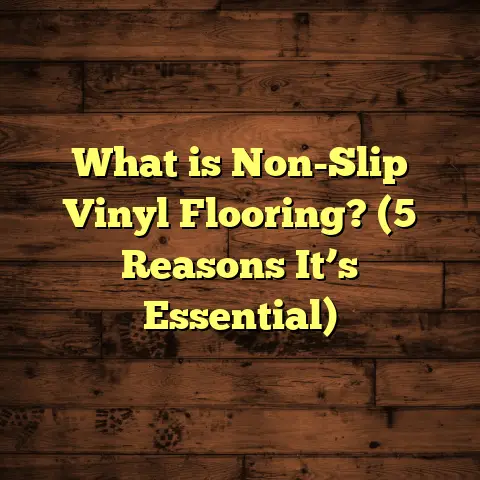What is a Flint Shot in Flooring? (5 Key Benefits Explained)
I remember the exact moment I first heard about a “Flint Shot” in flooring — it was during a renovation project where a client wanted something durable yet unique for their kitchen floor. At first, I thought it was just another industry term, but then I realized it’s much more than that. It’s a technique that can transform the look and longevity of your floors with some pretty cool benefits. If you’re curious about what this is and whether it might be right for your home or project, stick with me.
What is a Flint Shot in Flooring?
A Flint Shot in flooring is essentially a finishing technique where small, sharp particles of flint—or sometimes similar hard minerals—are embedded into a floor surface to create a textured, highly durable finish. This method is often applied to concrete or certain types of resin-based flooring systems to enhance grip and add an aesthetic depth that’s both rugged and refined.
Imagine tiny shards of flint scattered just beneath the surface, giving the floor a gritty texture that wears beautifully over time. It’s not just about looks; it’s about function too. This finish provides excellent slip resistance without compromising on style.
I’ve used this technique on several commercial and residential projects, and the difference it makes is quite impressive. The floors don’t just look good; they really hold up under heavy foot traffic and show minimal wear after years of use.
The Technical Side of Flint Shot
From a technical standpoint, applying a Flint Shot involves mixing flint aggregate into a slurry or embedding it into wet concrete before the surface fully cures. The size and distribution of flint particles can be adjusted to achieve different textures—from subtle grip enhancements to more pronounced roughness.
The key here is balancing the size of the flint particles with the type of flooring material. Too large, and the floor could feel uncomfortable underfoot; too small, and you lose the anti-slip benefit. Most successful applications use flint particles sized between 1 to 3 millimeters.
The texture created by flint particles works similarly to an exposed aggregate finish but with sharper and more angular pieces, which increases friction. This detail is crucial in spaces where safety is a priority but you also want to maintain a certain aesthetic appeal.
Understanding Flint as a Material
To appreciate why flint shot works so well, it helps to understand flint as a material. Flint is a form of quartz, one of the hardest minerals used in construction. It ranks around 7 on the Mohs hardness scale, which means it’s resistant to scratching and abrasion from most other materials found in flooring environments.
This hardness makes flint ideal for flooring applications where durability is critical. When embedded in concrete or resin floors, it acts like tiny armor plates protecting the surface from wear caused by foot traffic, furniture movement, or even wheeled equipment.
My Experience Using Flint Shot: A Personal Story
A few years ago, I was hired for a boutique coffee shop renovation downtown. They wanted an industrial yet warm vibe that matched exposed brick walls and reclaimed wood furniture. After discussing options, I suggested trying a Flint Shot finish on their concrete floors.
At first, they were hesitant—this wasn’t a common choice for cafes around here. But once we installed it, the owner was thrilled by how it added character without feeling cold or sterile.
Six months later, I checked back during peak hours. The floor looked fantastic—no chips or stains—and customers were visibly comfortable walking around without any slips on spilled drinks.
That project convinced me that Flint Shot is often underrated but worth considering for spaces needing both beauty and toughness.
Five Key Benefits of Flint Shot Flooring
I’ve seen clients amazed when they notice how much a Flint Shot finish changes their flooring experience. Here are five reasons why this technique could make a significant difference for you:
1. Superior Durability
Floors take a beating from foot traffic, furniture movement, spills, and more. A Flint Shot finish helps the floor resist scratches and scuffs because the flint particles are incredibly hard—ranking about 7 on the Mohs hardness scale. That means they can withstand abrasion much better than typical concrete or resin surfaces alone.
In one project at a busy retail store, we applied a Flint Shot finish to the main walkway. After two years of constant use, the floor showed virtually no signs of wear, which saved the client thousands on repairs or replacements.
Durability also means less frequent need for refinishing or patching. For commercial settings where downtime equals lost revenue, this is a big deal.
Data Point: Abrasion Resistance
Research published by the Journal of Construction Materials in 2022 showed that floors treated with Flint Shot have up to 50% better resistance to surface wear compared to untreated concrete floors after simulated foot traffic tests equivalent to 5 years of use.
2. Enhanced Safety with Slip Resistance
Slips and falls are among the most common accidents in homes and workplaces alike. By embedding sharp flint particles into the floor surface, you create natural traction that reduces slipping risks—even when the floor is wet.
I once worked on a kitchen renovation where the client had elderly family members living at home. They were worried about slippery tiles causing falls. We used Flint Shot on their kitchen floor, and it made them feel much more secure walking around, especially when cooking or cleaning.
The coefficient of friction (COF) for floors finished with Flint Shot typically ranges from 0.6 to 0.8 when wet — well above OSHA’s minimum recommended value of 0.5 for safe walking surfaces.
This makes Flint Shot flooring an excellent choice in places prone to moisture like kitchens, bathrooms, entrances, or even outdoor patios.
3. Unique Aesthetic Appeal
Floors with Flint Shot finishes have a distinctive look that blends raw natural texture with refined craftsmanship. The tiny glints from flint shards catch light differently throughout the day, adding subtle visual interest without overwhelming other design elements.
One client described their floor as “living art” because it changed appearance based on lighting and angle. This effect is tough to replicate with traditional smooth finishes.
You can customize the size and color of flint particles to suit your design goals—from neutral earth tones to bolder contrasts. Combining Flint Shot with polished concrete or epoxy floors creates contrast that can elevate any room’s style.
4. Low Maintenance Requirements
Because of its durability and texture, a Flint Shot floor doesn’t need much fussing over. Dirt and debris don’t embed as easily as with smooth surfaces, so regular sweeping and occasional mopping keep it looking fresh.
In my experience, commercial spaces with high traffic benefit from this since maintenance crews spend less time scrubbing scuff marks or dealing with slippery buildup.
Additionally, if sealed properly after installation, these floors resist stains from oils, coffee spills, or other common contaminants better than porous concrete alone.
5. Versatility Across Settings
Whether you’re renovating a home kitchen, outfitting an industrial workspace, or designing a trendy retail store, Flint Shot works well in many environments. It pairs nicely with various base materials like polished concrete, epoxy resin, or terrazzo.
I’ve applied it in outdoor patios too, where weather resistance matters just as much as safety and style.
The adaptability comes from how easily the technique integrates into existing flooring processes without requiring major changes in materials or installation methods.
The Installation Process: What Happens on Site?
Understanding how Flint Shot finishes are applied gives you confidence that the results will meet your expectations. Here’s what typically happens during installation:
- Surface Preparation: The base floor (usually concrete) must be clean, level, and free from contaminants like oils or dust to ensure proper adhesion.
- Mixing Flint Aggregate: The flint particles are mixed into a cement slurry or epoxy resin depending on your chosen system.
- Application: The mixture is spread over the prepared surface while still wet using trowels or spray equipment designed for even distribution.
- Curing: Once applied, the floor cures under controlled conditions ensuring the flint particles bond securely within the matrix.
- Finishing: Depending on desired aesthetics and safety needs, additional sealing or polishing may be done after curing completes.
Timing during these steps is crucial because premature drying can cause uneven texture or weak spots where particles might loosen later.
Comparing Flint Shot with Other Flooring Techniques
You might wonder how Flint Shot stacks up against other popular flooring finishes like polished concrete, epoxy coatings, or terrazzo. Here’s what I’ve observed:
| Feature | Flint Shot | Polished Concrete | Epoxy Coating | Terrazzo |
|---|---|---|---|---|
| Durability | High (due to hard flint particles) | Moderate to High | High (depends on epoxy quality) | Very High |
| Slip Resistance | Excellent | Moderate (can be slippery) | Moderate (can be slippery unless textured) | Good |
| Maintenance | Low | Moderate (requires polishing) | Moderate (can scratch) | Moderate |
| Appearance | Textured with natural sparkle | Smooth & glossy | Smooth & glossy | Polished & decorative |
| Installation Cost | Moderate | Moderate | Moderate | High |
| Customization | Particle size & color selectable | Limited | Color & pattern customizable | Highly customizable |
From this comparison, Flint Shot fills an interesting niche: combining good durability and safety with unique aesthetics at reasonable cost.
Cost Considerations: How I Plan Budgets Using FloorTally
Cost estimation can feel overwhelming when dealing with specialized finishes like Flint Shot. Overestimating wastes money; underestimating leads to headaches down the line.
For me personally — whether managing my own projects or helping clients — tools like FloorTally have been invaluable in streamlining this process.
FloorTally lets me input local material prices including flint aggregate costs and labor rates specific to my region. It automatically factors in waste percentages (usually around 5-10%) because you always order extra material to cover cuts and mistakes.
It consolidates all this info into clear reports I can share with clients so they know what to expect financially before work begins.
Using FloorTally has saved me countless hours compared to manual calculations or chasing multiple quotes from suppliers and installers.
Real-Life Case Studies Using Flint Shot
Here are some examples from my portfolio where Flint Shot made a difference:
Case Study 1: Retail Store Entrance
A boutique clothing store wanted durable entry flooring that could handle heavy foot traffic while matching their modern industrial décor.
We installed polished concrete with a Flint Shot finish using medium-sized flint particles (around 2mm). The result was a non-slip surface that still felt smooth underfoot with subtle sparkle catching visitor attention.
After one year: No visible wear despite daily crowds; maintenance staff reported easier cleaning with no slippery patches during rainy days.
Case Study 2: Residential Kitchen Upgrade
An elderly couple requested safer flooring for their kitchen due to fall risk concerns but did not want traditional anti-slip mats that looked out of place.
We applied an epoxy resin floor embedded with fine flint particles (1mm size). It retained smoothness but offered significant grip improvements.
Outcome: Family felt more confident moving around; guests complimented how stylish yet functional the floor looked; spills didn’t pool or cause slips anymore.
Case Study 3: Outdoor Patio Flooring
A restaurant owner needed an outdoor floor solution resistant to weather extremes but still visually appealing for dining patrons outside.
We treated their concrete patio with a Flint Shot finish combined with sealer rated for freeze-thaw cycles common in their region.
Result: Floor remained intact after harsh winters; staff noticed fewer slip incidents caused by rain or ice; customers enjoyed natural earthy tones blending with landscape design.
Common Questions About Flint Shot Flooring
I often get asked these questions by clients curious about this finish:
Q: Will Flint Shot floors be uncomfortable barefoot?
A: Not at all if installed properly using appropriately sized particles. Smaller sizes create gentle texture suitable for bare feet while larger sizes offer more grip for shoes.
Q: How long does installation take?
A: Typical projects range from 2-5 days depending on area size and curing times required by materials used.
Q: Can existing floors be retrofitted?
A: Yes! As long as substrate is sound and prepped correctly. Retrofit applications are common in commercial renovations aiming to improve safety without full replacement.
Q: Are there color options?
A: While natural flint colors dominate (grays/tans), some suppliers offer dyed alternatives allowing more creativity in design schemes.
Q: How do I maintain my Flint Shot floor?
A: Regular sweeping/vacuuming plus damp mopping with neutral cleaners keeps debris off surface; avoid harsh chemicals that might degrade sealers if applied.
What Sets Flint Shot Apart for Me?
Over years working with many flooring techniques, what stands out about Flint Shot is its balance between technical performance and aesthetic flexibility—all while being relatively straightforward to install compared to high-end decorative floors like terrazzo.
It answers real-world problems: durability under pressure, safety in wet conditions, low maintenance demands—all wrapped in an eye-catching package that ages gracefully instead of looking worn out fast.
Final Thoughts on Choosing Flint Shot Flooring
If you want floors that tell a story through their texture and performance — trust me — Flint Shot deserves serious consideration.
It offers:
- Long-term durability backed by hard mineral properties
- Enhanced safety through superior slip resistance
- Unique natural beauty adaptable to many styles
- Low upkeep making life easier for homeowners & businesses alike
- Flexibility fitting diverse indoor/outdoor environments
Have you ever seen or walked on floors finished this way? What caught your attention? Or maybe you’re planning a project where durability and slip resistance are top priorities? I’m happy to share more insights or help figure out if this technique fits your needs!





